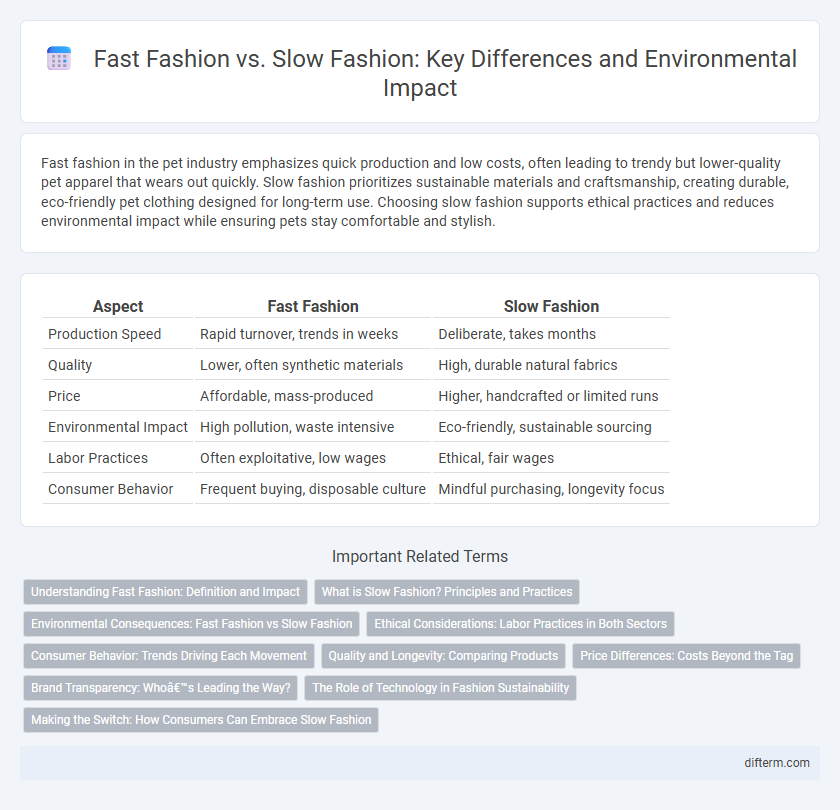Fast fashion in the pet industry emphasizes quick production and low costs, often leading to trendy but lower-quality pet apparel that wears out quickly. Slow fashion prioritizes sustainable materials and craftsmanship, creating durable, eco-friendly pet clothing designed for long-term use. Choosing slow fashion supports ethical practices and reduces environmental impact while ensuring pets stay comfortable and stylish.
Table of Comparison
| Aspect | Fast Fashion | Slow Fashion |
|---|---|---|
| Production Speed | Rapid turnover, trends in weeks | Deliberate, takes months |
| Quality | Lower, often synthetic materials | High, durable natural fabrics |
| Price | Affordable, mass-produced | Higher, handcrafted or limited runs |
| Environmental Impact | High pollution, waste intensive | Eco-friendly, sustainable sourcing |
| Labor Practices | Often exploitative, low wages | Ethical, fair wages |
| Consumer Behavior | Frequent buying, disposable culture | Mindful purchasing, longevity focus |
Understanding Fast Fashion: Definition and Impact
Fast fashion refers to inexpensive, trendy clothing produced rapidly to meet consumer demand, often at the expense of environmental sustainability and ethical labor practices. This business model relies on quick turnaround times, mass production, and disposable garments that contribute significantly to textile waste and pollution. Its impact includes resource depletion, increased carbon emissions, and exploitation of workers, contrasting sharply with the principles of slow fashion that emphasize quality, longevity, and ethical responsibility.
What is Slow Fashion? Principles and Practices
Slow fashion emphasizes sustainable production by prioritizing quality over quantity, ethical labor practices, and environmentally friendly materials. It promotes durability, timeless design, and transparency in the supply chain to reduce waste and pollution. Brands adopting slow fashion focus on local sourcing, fair wages, and encouraging consumers to buy less but better.
Environmental Consequences: Fast Fashion vs Slow Fashion
Fast fashion generates massive textile waste and high carbon emissions due to rapid production cycles and disposable trends, severely impacting landfills and pollution levels. Slow fashion emphasizes sustainable materials, ethical manufacturing, and durability, significantly reducing environmental footprints by minimizing resource consumption and waste. Choosing slow fashion supports lower greenhouse gas emissions and less water contamination compared to the resource-intensive processes inherent in fast fashion.
Ethical Considerations: Labor Practices in Both Sectors
Fast fashion often relies on low-wage labor and poor working conditions in developing countries, raising serious ethical concerns about exploitation and workers' rights. Slow fashion promotes fair wages, safe working environments, and transparency in supply chains, emphasizing ethical labor practices. Consumers choosing slow fashion support sustainable livelihoods and increased accountability in the global apparel industry.
Consumer Behavior: Trends Driving Each Movement
Fast fashion thrives on consumer demand for affordable, trendy clothing, encouraging frequent purchases through rapid product turnover and social media influence. Slow fashion appeals to environmentally conscious buyers who prioritize quality, durability, and ethical production, driving a shift towards sustainable shopping habits. Consumer behavior increasingly reflects a divide between impulsive shopping for immediacy and deliberate choices valuing long-term impact and responsibility.
Quality and Longevity: Comparing Products
Fast fashion garments are typically made with lower-quality materials and manufacturing processes, resulting in shorter product lifespans and increased environmental waste. Slow fashion emphasizes durable fabrics and meticulous craftsmanship, producing items designed to last and maintain their appearance over time. Investing in slow fashion reduces the frequency of replacements and contributes to sustainable wardrobe practices.
Price Differences: Costs Beyond the Tag
Fast fashion offers lower upfront prices by relying on mass production and cheaper materials, but these cost savings often lead to hidden expenses such as environmental degradation and poor labor conditions. Slow fashion emphasizes quality craftsmanship and sustainable materials, resulting in higher initial costs that reflect fair wages and eco-friendly practices. Consumers investing in slow fashion ultimately contribute to a more ethical supply chain and reduced long-term environmental impact, contrasting sharply with the externalized costs embedded in fast fashion's low price tags.
Brand Transparency: Who’s Leading the Way?
Brand transparency in fast fashion often lacks comprehensive disclosure on sourcing and labor practices, while slow fashion brands prioritize full transparency to build consumer trust and promote ethical standards. Companies like Patagonia and Eileen Fisher lead the way by publishing detailed supply chain reports and sustainability metrics, setting industry benchmarks. Increased demand for accountability has pushed emerging slow fashion brands to adopt blockchain technology for traceability and verifiable brand transparency.
The Role of Technology in Fashion Sustainability
Technology plays a pivotal role in advancing fashion sustainability by enabling faster, more efficient production processes in both fast and slow fashion sectors. Innovations such as 3D printing, AI-driven design, and blockchain for supply chain transparency help reduce waste and improve resource management. Digital platforms also empower consumers to make informed choices, fostering a culture of sustainability across the fashion industry.
Making the Switch: How Consumers Can Embrace Slow Fashion
Consumers can embrace slow fashion by prioritizing quality over quantity, choosing durable, ethically made garments that reduce environmental impact. Investing in timeless pieces and supporting brands with transparent supply chains fosters sustainability and counters the wastefulness of fast fashion. Adopting mindful shopping habits, such as buying secondhand or repairing clothes, further promotes a more responsible fashion industry.
Fast fashion vs slow fashion Infographic

 difterm.com
difterm.com